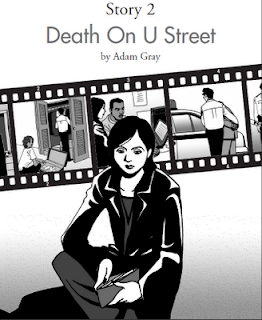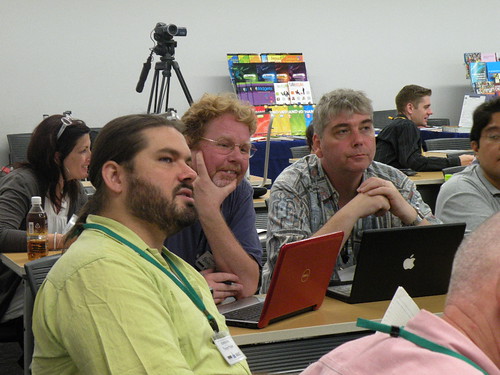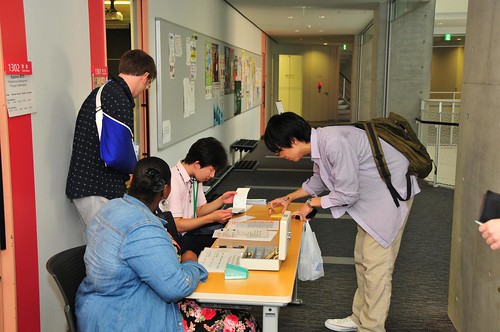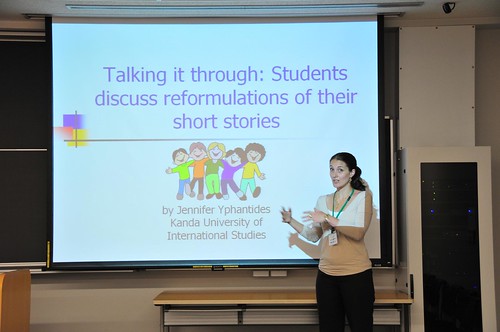Hello everyone,
Today we are going to review Chapter 1: The Victim, and take our first quiz.Look at the image below. The image is a mind map (マインドマップ). Mind maps are a great way to take notes. The mind map below is about the scene of the crime.
Open your Detective's notebook to p. 10. Fill in the crime report. Use the information in the mind map to help you.
OK, now let's review some vocabulary. Click this link: 応用英語1-2B Chapter 1.
Now turn to p. 92. Do the Police Briefing. After that we'll take the first quiz.
Now let's do the pre-reading on p. 94.
Finally, for homework please read Chapter 2 and do the tasks.
By the way, you can learn more about learning English with mind maps by reading my friend Chris Foskett's book: マインドマップ英語勉強法.
This blog serves several purposes: Communicating with my students outside of the classroom, publishing my students' work, and it serves as a resource for both students and teachers.
Thursday, September 30, 2010
Tuesday, September 28, 2010
Toyo Gakuen University 応用英語1-3B Writing Unit 5: My Seal Part 2
Hello everyone,
Today we continue working on our first writing task: My Seal.
First, let's study some vocabulary. Click this link: 基礎英語ステップ1. Do 2 iKnow lessons.Now let's practice typing: Click this link: Qwerty Warriors. Click "Play". Select "medium". Play the game two times.
Now let's look at some paragraph's written by Shibaura Institute of Technology students.
Read Akihito's paragraph about his seal and answer the questions below.
Akihito's Seal
My seal has three symbols: a bird, planets, a cross and a die. The bird is in the center. It represents my hope because a bird is free and can go everywhere. I want to be free and go everywhere. Above the bird there are planets. They represent the places where I have not been. I want to travel to various places and find new things. Below the bird there is a die and a cross. They represents my way of thinking about science. They express Albert Einstein’s words, “”God does not throw dice with the universe" [神は宇宙とサイコロを再生されません。]. I really like science and I want to be a person who says aphorisms [格言] like this.
- What are the three symbols in Akihito's seal?
- What do the symbols represent?
Next, read Masako's paragraph about her seal. Then, draw Masako's seal.
Masako's Seal
My seal has four symbols: a softball, a musical note, five stars, and a cat. The five stars are in the center. They represent my home country’s national flag. They represent China
Monday, September 27, 2010
Toyo Gakuen University Introduction to Business English B Unit 7: People
Hello everyone. Today we are going to learn how to describe the kind of people we want to be, and the kind of people we want to work with.
Let's learn some new vocabulary. Click this link: Introduction to Business English Vocabulary Review.
Read the paragraph below. The paragraph is about the kind of people I like to work with.
I like to work in a team. I like to work with collaborative people. They motivate me. I like to work with creative people. They make me creative too. I like to create. I like to work with hard-working people, because I like to work hard. I like to work with helpful people. Perhaps most importantly, I like to work with loyal people. I like to work with collaborative, creative, hard-working, helpful, and loyal people
How about you? What kind of people do you like to work with. Please leave a comment below.
Let's learn some new vocabulary. Click this link: Introduction to Business English Vocabulary Review.
Read the paragraph below. The paragraph is about the kind of people I like to work with.
 |
| Image by Lumaxart |
I like to work in a team. I like to work with collaborative people. They motivate me. I like to work with creative people. They make me creative too. I like to create. I like to work with hard-working people, because I like to work hard. I like to work with helpful people. Perhaps most importantly, I like to work with loyal people. I like to work with collaborative, creative, hard-working, helpful, and loyal people
How about you? What kind of people do you like to work with. Please leave a comment below.
Class rules made by Toyo Gakuen University and Shibaura Institute of Technology students 2010
As usual, at the beginning of each semester, we make rules for our classes. In the box below you can see some rules made by students at Toyo Gakuen University and Shibaura Institute of Technology in the spring and autumn semesters this year.
Some of my favourites are:
In some classes at Toyo Gakuen University, we were in a Computer Assisted Language Learning (CALL) room, and I asked the students to look at the cartoon I posted on this blog on the 13th of September, and then write some rules for the class by leaving a comment. Click the link to see the cartoon and the students' rules in the comment section. In other classes, I printed the cartoon and showed it to the students. I asked them to write some rules. I made it a race actually. After that we went over the rules correcting grammar, and making some changes to the rules. This was part of the negotiation process (折衝[交渉]過程[プロセス]). In the pictures you will see that some rules are crossed out. That's because sometimes singing and dancing are OK in my classes. I did make a mistake. I crossed out the wrong rule in one of the photos. Can you guess which one?
Some of my favourites are:
- We should keep a smile on our faces.
- If we forget our textbook we should make a copy of our friend's textbook.
- Our teacher must help us get 100% on the test.
- Mr. Stout must give us a fair grade.
- The teacher must remember to bring whiteboard markers to class.
In some classes at Toyo Gakuen University, we were in a Computer Assisted Language Learning (CALL) room, and I asked the students to look at the cartoon I posted on this blog on the 13th of September, and then write some rules for the class by leaving a comment. Click the link to see the cartoon and the students' rules in the comment section. In other classes, I printed the cartoon and showed it to the students. I asked them to write some rules. I made it a race actually. After that we went over the rules correcting grammar, and making some changes to the rules. This was part of the negotiation process (折衝[交渉]過程[プロセス]). In the pictures you will see that some rules are crossed out. That's because sometimes singing and dancing are OK in my classes. I did make a mistake. I crossed out the wrong rule in one of the photos. Can you guess which one?
Saturday, September 25, 2010
Shibaura Institute of Technology Writing 1B 2010 Semester 2 Lesson 1
Today is the first day of the Writing 1B class at Shibaura Institute of Technology. You can read the course syllabus and see examples of work done by students in previous classes by clicking the links below:
Please let me about yourself. Write a comment below. Watch the video to learn how to post a comment.
Friday, September 24, 2010
応用英語1-2B Reading Lesson 2: Death on U Street Chapter 1
Hello everyone! Today we start reading our exciting story, Death on U Street.
In today's lesson we will:
OK, let's learn about U Street.
U Street is the main street in a neighbourhood in Washington D.C in the United States. Look at the picture below.
The U Street neighbourhood is a large African American community. The famous jazz artist Duke Ellington lived there. Look at the picture below. You can see a painting of Duke Ellington on the building.
You can learn more about U Street from wikipedia. Click the link: U Street Corridor
OK, now let's learn some vocabulary. Click this link: 応用英語1-2B Reading.
Next, let's open our textbook to page 79. Let's learn about the Detective's Notebook and let's read the story.
Your homework is to finish reading Chapter 1 and do the puzzle. Next week we'll have the first quiz.
Enjoy!
 |
| Illustration by Yuji Tachikawa. Abax. Some rights reserved |
In today's lesson we will:
- Learn about the real U Street
- Learn some crime story vocabulary
- Read chapter 1: The Victim
- Learn why there are fingerprints over the text in the story
- Learn how to use the Detective's Notebook
- Answer the Chapter 1 puzzle

OK, let's learn about U Street.
U Street is the main street in a neighbourhood in Washington D.C in the United States. Look at the picture below.
 |
| Uploaded to wikipedia by AgnosticPreachersKid |
The U Street neighbourhood is a large African American community. The famous jazz artist Duke Ellington lived there. Look at the picture below. You can see a painting of Duke Ellington on the building.
 |
| Uploaded by Audeviver to wikipedia. Some rights reserved |
OK, now let's learn some vocabulary. Click this link: 応用英語1-2B Reading.
Next, let's open our textbook to page 79. Let's learn about the Detective's Notebook and let's read the story.
Your homework is to finish reading Chapter 1 and do the puzzle. Next week we'll have the first quiz.
Enjoy!
Wednesday, September 22, 2010
Toyo Gakuen University 応用英語I-3B Writing Unit 5: My Seal Part 1
Hello everyone!
Today we are going to start our first writing task: My Seal. Look at the picture below. The picture is the Great Seal of Canada. In the middle of the Great Seal of Canada you can see the Queen. The Queen represents Canada. She is a symbol (事物の象徴[を表す記号]) of Canada.
Look at the picture below. You will design a seal and write a paragraph about it.
First, let's study some vocabulary. Click this link: 基礎英語ステップ1. Do 2 iKnow lessons.
Now let's practice typing: Click this link: Qwerty Warriors. Click "Play". Select "medium". Play the game two times.
Now let's get started. Open your books to page 44.
Finally, please post a comment below. Tell me about your plans for the holiday on tomorrow.
Today we are going to start our first writing task: My Seal. Look at the picture below. The picture is the Great Seal of Canada. In the middle of the Great Seal of Canada you can see the Queen. The Queen represents Canada. She is a symbol (事物の象徴[を表す記号]) of Canada.
Look at the picture below. You will design a seal and write a paragraph about it.
 |
| Writing from Within Intro p.47 ©2004 CUP |
First, let's study some vocabulary. Click this link: 基礎英語ステップ1. Do 2 iKnow lessons.
Now let's practice typing: Click this link: Qwerty Warriors. Click "Play". Select "medium". Play the game two times.
Now let's get started. Open your books to page 44.
Finally, please post a comment below. Tell me about your plans for the holiday on tomorrow.
Monday, September 20, 2010
MASH Equinox Tokyo at Toyo Gakuen University
What did you do on the long week-end? I spent my long week-end at Toyo Gakuen University Hongo Campus. I spent 4 days at a fantastic conference at Toyo Gakuen University Hongo campus called MASH Equinox Tokyo 2010.
Other Toyo Gakuen University teachers and students participated in the conference too. Andy Boon was one of the organisers. Daniel Beck did a great pecha kucha (ペチャクチャ) presentation. Hitomi Sakamoto-sensei, Clair Taylor, and Clare Murray attended the conference. Most importantly, Toyo Gakuen University students volunteered to help out at the conference. We were all very proud of them.
I was also delighted to see my friend Jennifer Ypantidis give a great presentation. We worked together at Kanto International High School.
There will be many more conferences at Toyo Gakuen University this year. Why don't you volunteer to help out at a conference? If you volunteer at a conference you will meet many kind and interesting people and you will have a great chance to practice speaking English.
 |
| ©MASH Collaboration 2010 http://flic.kr/p/8C6gVt |
Other Toyo Gakuen University teachers and students participated in the conference too. Andy Boon was one of the organisers. Daniel Beck did a great pecha kucha (ペチャクチャ) presentation. Hitomi Sakamoto-sensei, Clair Taylor, and Clare Murray attended the conference. Most importantly, Toyo Gakuen University students volunteered to help out at the conference. We were all very proud of them.
 |
| ©MASH Collaboration 2010 http://flic.kr/p/8C6DSX |
 |
| Clair Taylor and Scott Thornbury |
 |
| Clair Taylor and Michael Stout having a laugh at MASH Equinox 2010 |
 |
| ©MASH Collaboration 2010 http://flic.kr/p/8C6DsH |
There will be many more conferences at Toyo Gakuen University this year. Why don't you volunteer to help out at a conference? If you volunteer at a conference you will meet many kind and interesting people and you will have a great chance to practice speaking English.
Thursday, September 16, 2010
応用英語1-2B Reading Lesson 1: Introduction to the course
Hello everyone!
Today is an introduction to English 1-2B Intensive Reading. In this lesson you will learn how to:
Next, let's look at our textbook. Please look at the image below.
There are two detective stories in Whodunit. Last semester we read the first story, The Inverted Eagle. Click the link to read some reviews of The Inverted Eagle, and messages from the writers, Adam Gray and Marcos Benevides. Scroll down to the comments section. Read the comments and answer the questions below.
Now let's learn some useful vocabulary for reading detective stories. First, please click this link: smart.fm signup. Next please click the link: 応用英語1-2B Reading.
Finally, please click this link: Class Rules. Read the post. Post a comment.
Your homework is to finish your reading plan.
See you next week!
Today is an introduction to English 1-2B Intensive Reading. In this lesson you will learn how to:
- subscribe to this blog
- make a blog comment
- register for and use smart.fm - an online vocabulary study site.
- make a reading plan
Next, let's look at our textbook. Please look at the image below.
 |
| Front cover of Whodunit by Adam Gray and Marcos Benevides. Published by Abax. Some rights reserved. |
- How many students liked the story?
- How many students disliked the story?
- What did Mr. Benevides say about the second story, Death on U Street?
- What did Mr. Gray say about the second story, Death on U Street?
Now let's learn some useful vocabulary for reading detective stories. First, please click this link: smart.fm signup. Next please click the link: 応用英語1-2B Reading.
Finally, please click this link: Class Rules. Read the post. Post a comment.
Your homework is to finish your reading plan.
See you next week!
Wednesday, September 15, 2010
Toyo Gakuen University 応用英語I-3B Writing Lesson 1
Hello everybody! Welcome to the first 応用英語I-3B Writing class. Today we will learn:
* How to subscribe to this blog
* How to register for smart.fm
* How to use smart.fm
* How to write a blog post
You can see the textbook in the picture below. Our textbook was written by two great teachers called Curtis Kelly and Arlen Gargagliano. You can read a message from Curtis and Arlen. Look for the message near the end of the comments.
Now look below. This is our course outline.
You must type your writing tasks in this class. Let's practice typing with a fun game called Qwerty Warriors
You must also review vocabulary, and learn new vocabulary too. You can do this with online flashcards. Let's go to an online flashcard website called smart.fm. Click this link: https://smart.fm/signup
Next, please click this link: Class Rules. Read the post. Post a comment.
That's all for today. See you next week!
* How to subscribe to this blog
* How to register for smart.fm
* How to use smart.fm
* How to write a blog post
You can see the textbook in the picture below. Our textbook was written by two great teachers called Curtis Kelly and Arlen Gargagliano. You can read a message from Curtis and Arlen. Look for the message near the end of the comments.
 |
© 2004 CUP |
You must type your writing tasks in this class. Let's practice typing with a fun game called Qwerty Warriors
You must also review vocabulary, and learn new vocabulary too. You can do this with online flashcards. Let's go to an online flashcard website called smart.fm. Click this link: https://smart.fm/signup
Next, please click this link: Class Rules. Read the post. Post a comment.
That's all for today. See you next week!
My Summer Vacation
Hi everyone!
I made a video about my summer vacation.
Watch the video. Make a list of things you see in the video. Write at least 12 things.
Enjoy!
I made a video about my summer vacation.
Watch the video. Make a list of things you see in the video. Write at least 12 things.
Enjoy!
Monday, September 13, 2010
Class Rules

Hi everyone. Please look at the cartoon. This class needs some rules. Make a list of rules for the students and the teacher. You can post them as a comment below.
You can see some examples written by other students. Click this link: Class Rules
I'll post the rules you make next week.
Enjoy!!
Introduction to Business English 1B ビジネス英語入門 B Introductory Lesson
Hello everyone! Today is the first day of semester two, and this is my first class!!
Welcome to Introduction to Business English B.
Today we are going to learn about the course. We will read the course outline, and we will watch a video too. We will learn how to greet people in business situations, and we will look at the textbook.
This lesson will be review for students who took Introduction to Business English A.
OK, let's start.
Please click this link: Exchanging business cards. Watch the video and do the quiz.
Now let's learn some vocabulary. Please click this link: TYG Introduction to Business Vocabulary.
Next, please look at the image below. This is your textbook.You can buy the textbook next lesson.
Finally, please look below. You can see the course outline. Please download the course outline and save it to your own folder.
Toyo Gakuen University Introduction to Business English B Course Outline
That's all. I hope you decide to take this class. Business English is becoming very important for getting a job in Japan. Two famous Japanese companies, Uniqlo and Rakuten are making English the official company language. I think many more Japanese companies will do the same. You can read about it here:楽天:英語を12年中に社内公用語化 English will be the official language of Rakuten!
Please leave a comment. Your homework is to send me an e-mail. I hope to see you next week.
Welcome to Introduction to Business English B.
Today we are going to learn about the course. We will read the course outline, and we will watch a video too. We will learn how to greet people in business situations, and we will look at the textbook.
This lesson will be review for students who took Introduction to Business English A.
OK, let's start.
Please click this link: Exchanging business cards. Watch the video and do the quiz.
Now let's learn some vocabulary. Please click this link: TYG Introduction to Business Vocabulary.
Next, please look at the image below. This is your textbook.You can buy the textbook next lesson.
 |
| Market Leader Elementary © 2007 |
Finally, please look below. You can see the course outline. Please download the course outline and save it to your own folder.
Toyo Gakuen University Introduction to Business English B Course Outline
That's all. I hope you decide to take this class. Business English is becoming very important for getting a job in Japan. Two famous Japanese companies, Uniqlo and Rakuten are making English the official company language. I think many more Japanese companies will do the same. You can read about it here:楽天:英語を12年中に社内公用語化 English will be the official language of Rakuten!
Please leave a comment. Your homework is to send me an e-mail. I hope to see you next week.
Friday, September 10, 2010
Cool tools for back to school
Well school starts again on Monday! So, let's review some cool tools for making cartoons and animated videos. We will be using these tools in Semester 2.
First, look at the cartoon below. I made it with ToonDoon.

You can see more of my posts about comics. Click this link: Comics
Next, look at the video below. I made this video using GoAnimate.
Finally, look at the video below. The video below was made by a Toyo Gakuen University student called Marina K.
See you on Monday!
First, look at the cartoon below. I made it with ToonDoon.

You can see more of my posts about comics. Click this link: Comics
Next, look at the video below. I made this video using GoAnimate.
Finally, look at the video below. The video below was made by a Toyo Gakuen University student called Marina K.
See you on Monday!
Subscribe to:
Comments (Atom)


